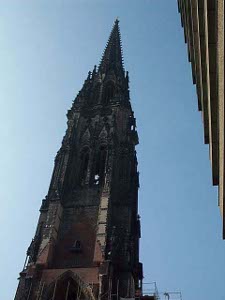 Swans beneath the Alster arcade
Swans beneath the Alster arcade
After a week of cloudy skies and sprinkles in Munich we were glad to see the sunny fall weather in Hamburg as we started our downtown walk.
 Swans beneath the Alster arcade
Swans beneath the Alster arcade
Hamburg lies on the Elbe River, its outlet to the sea, and also contains the Alster, a large man-made lake. Canals complete this rather complex water system, which is busy with both commercial and recreational boating of all kinds.
Our route took us past the Alster, one of the two places where we plan to take a boat ride, and the Rathaus, or city parliament, to the art museum behind the train station, through an Iranian neighborhood, the museum of arts and crafts, and several churches.
Soon we realized that even less of old Hamburg was left than Munich. After surviving the Great Fires of 1284 and 1842, the city was virtually destroyed by the bombing of 1943. There are some prewar buildings standing, but even those are mostly 19th centure construction. Nevertheless, there are interesting and lovely facades, such as the Chilihaus (1920s).
 Rathaus
Rathaus
The churches were bombed, too. We saw two that had been rebuilt with brick and plaster, with a few statues and a crucifix from ancient times, and one, St. Nicholas that was so badly damaged that only the huge steeple was standing. Some of the bomb-damaged foundation was left standing; the church location was left as a memorial. We noticed a sign that read Exhibition, and descended into the former church crypt.
There a gentleman in his fifties who spoke excellent English explained that a private citizens group had moved to save the property as an anti-war memorial. The current exhibit was prepared by a Polish group, depicting the horrible savaging of Poland and its people by the Germans and, even more horribly, by the Russians. One photo that caught our eye showed the young Khruschev as a Red Army officer in Poland around 1940. Afterwards, we spoke to the gentleman about the fighting in the Middle East, and he told us that Germany was now a strong backer of Israel. That may or may not be true, but we  Chilihaus
certainly were convinced that the political attitudes of Hamburgers were much more liberal than those of the Munichers.
Chilihaus
certainly were convinced that the political attitudes of Hamburgers were much more liberal than those of the Munichers.
Here in northern Germany, many of the formerly Catholic churches are now Protestant, some of them apparently quite liberal, like the one near the University. A curious custom which we haven't seen elsewhere is the presence of shops, absolutely unrelated to church activities, occupying church propetry. There is a locksmith and a sales office for kitchen equipment at one church, a wine cellar under another.
All cities are best in something, or what's a chamber of commerce for? Hamburg is the second largest port in Europe, and has 2,321 bridges, more than any other city. After crossing several of them, we followed a high barbed-wire fence to gain entry to the free-trade zone, carefully guarded by German customs.
 St. Nicholas spire
St. Nicholas spire
Inside was the Customs Museum. This time the man on duty was a former merchant seaman, who had sailed back and forth across the North Atlantic from Hamburg to the Great Lakes ports during the fifties and sixties, and then sensibly landed a better job staying at home as a customs agent. There were a number of the usual smuggling exhibits such as cocaine in the hollowed-out golf clubs or a carton of cigarettes in a loaf of bread, but most interesting was a short film about the Eastern European emigrants.
It seems an enterprising young businessman borrowed his last mark to start up what became the Hamburg-American Line, which specialized in transporting immigrants to America. The film clip was a dramatization of a young Polish couple who sold everything to get money for the trip, survived the disease-ridden crowded trains and detention barracks, and made it to the United States.
Hamburg has carefully kept records of some five million emigrants who passed through the port on their way to America; Bob thinks his grandparents may be among them. They are putting all the data on the internet; the project should be completed in 2006.
 Inner Harbor
Inner Harbor
As noon approached, the streets grew more and more busy, with shoppers, sightseers and folks just out for a stroll; very few tourists, and no tour groups today -- hooray!
We finished today's walk just reaching the shores of the Elbe River, with its shipyards and waterfront facilities. There were dozens of cruise boats, large and small, and we gathered literature and information. We may have to take a Mississippi paddle-wheeler in order to have an English tour guide!
By the time we decided to return to the hotel and type up our diary, the streets were crowded with Hamburgers enjoying the fine weather and arcades full of shops.
We like this seafaring and port city; close to the Danish and Dutch borders, and with a centuries-long tradition of trade, its people seem to be more open. We'll report more as our touring continues.